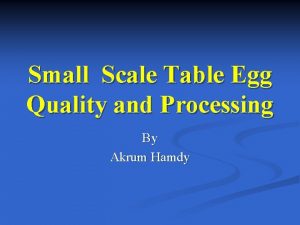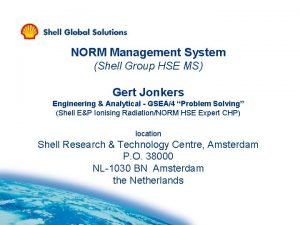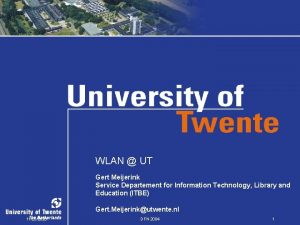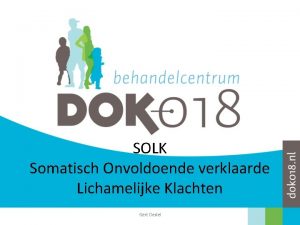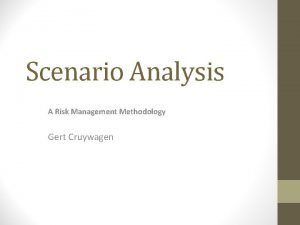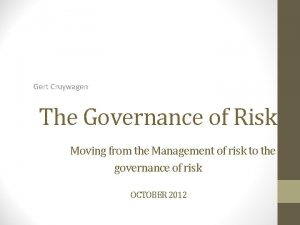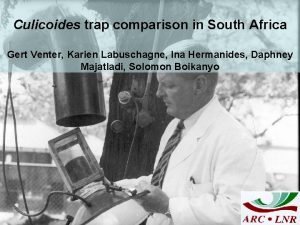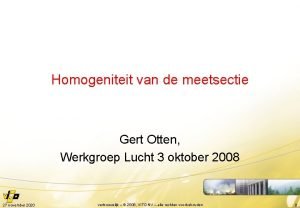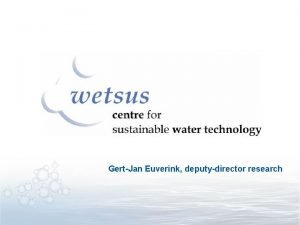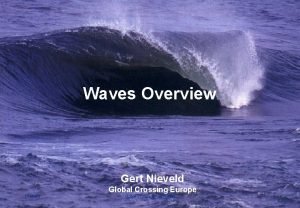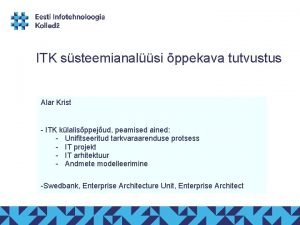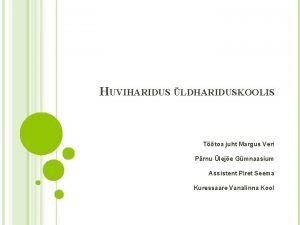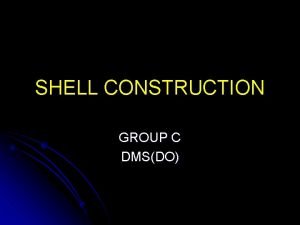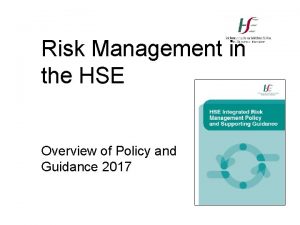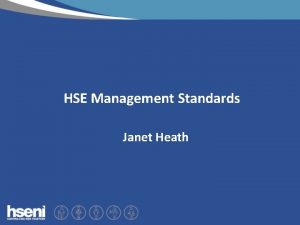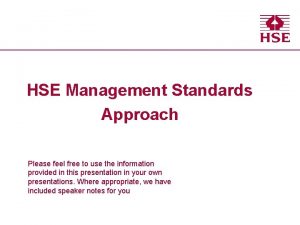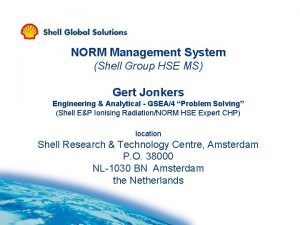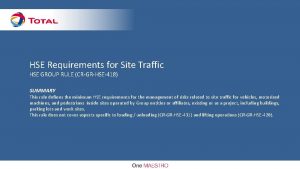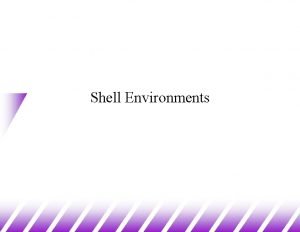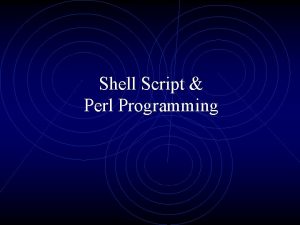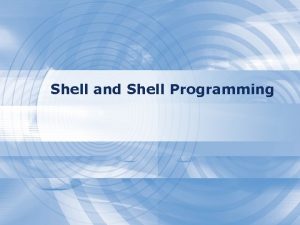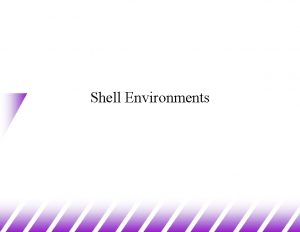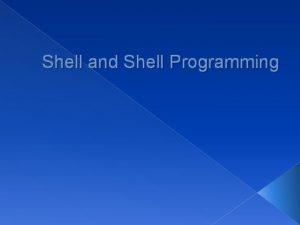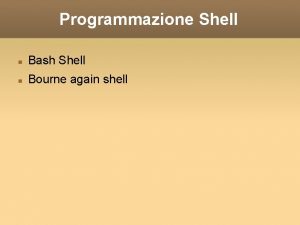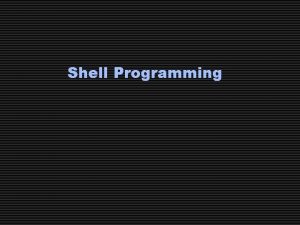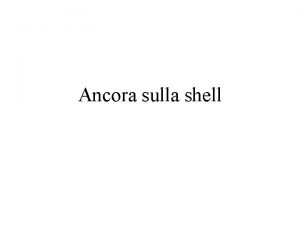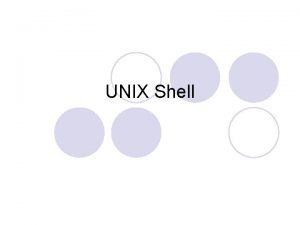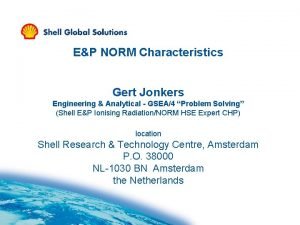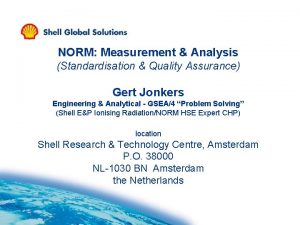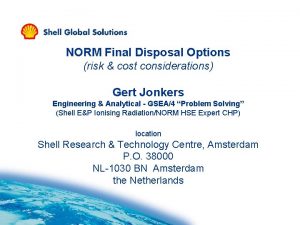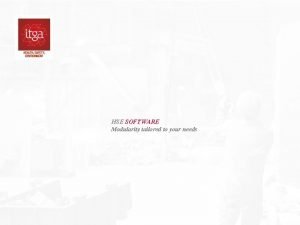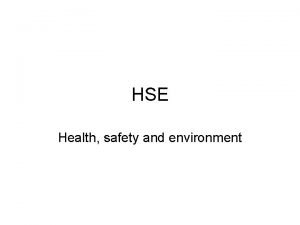NORM Management System Shell Group HSE MS Gert






















- Slides: 22

NORM Management System (Shell Group HSE MS) Gert Jonkers Engineering & Analytical - GSEA/4 “Problem Solving” (Shell E&P Ionising Radiation/NORM HSE Expert CHP) location Shell Research & Technology Centre, Amsterdam P. O. 38000 NL-1030 BN Amsterdam the Netherlands

EXPLOIT ALL a priori KNOWLEDGE ON E&P NORM FLARE FUEL GAS FLARE K. O. DRUM GAS SCRUBBER PRODUCTION MANIFOLD GAS SCRUBBER 2 ND STAGE SEPARATOR 1 ST STAGE SEPARATOR DEHYDRATOR OIL SHIPPING PUMP FLOTATION CELL SKIMMED OIL PUMP DEAERATOR WELLHEADS PRODUCTION TUBING METERING EXPORT PACKAGE LINE OVERBOARD PUMP S. W. SERVICES COOLERS ETC. WATER FLOOD INJECTION SEA WATER PUMP SEA WATER BOOSTER PUMP 2 G. Jonkers, GSEA/4 at SRTCA P. O. Box 38000, 1030 BN Amsterdam E&P NORM Workshop Muscat, February 21 -24, 2005 tel. +31 20 630 3424 Gert. Jonkers@Shell. com

Effective Radiation Protection Programme IAEA, Operational Radiation Protection - Safety Guides , Safety Series 101 1990 IAEA, Recommendations for the Safe Use and Regulation of Radiation Sources in Industry, Medicine, Research and Teaching , Safety Series 102, 1990 Organisation & Management committed to Safety & ALARP Successful Personnel Selection & Training Effective Occupational Radiation Control Effective Public Radiation Control Effective Emergency Planning & Preparedness Implementation Quality Assurance 1. Effective 1. Appropriate 1. Effective Control of 1. Identification of Management Structure 2. Clearly Documented Authorities, Responsibilities, Job descriptions 3. Adequate resources 4. Commitment to Safety & ALARP from all Employees Selection Criteria 2. Complete Post. Appointment Training Doses and Intakes 2. Adequate Control Standards 3. Effective Surveillance Potential Sources of Public Exposure 2. Adequately Derived and Documented Criteria to Limit Public Exposure Potential Accident Situations 2. Evaluation Unidentified Accident Situations 3. Preparation Contingency Plans 4. Exercise Contingency Plans 5. Periodic Review Emergency Plans Components Requiring Formal Quality Assurance 2. Identification of Applicable Standards 3. Adequate Appraisal Regimes ad 1) adequate corporate/site structure, seniority safety management, safety independent of production ad 2) production/safety: publish policies, clear organisation chart ad 3) production/safety: competent staff, adequate facilities ad 4) training, appraisal ratings include safety performance ad 1) documented qualification requirements for all levels, minimum age requirements, identified and documented medical requirements ad 2) formal review training requirements, documented training objectives, adequate scope of training programme, induction training to rectify deficiencies G. Jonkers, GSEA/4 at SRTCA P. O. Box 38000, 1030 BN Amsterdam ad 1) adequate control of source, provision of physical barriers, provision of administrative controls ad 2) adequately derived standards, adequately documented standards, pre-determined reference and action levels ad 3) adequate monitoring of workplace, appropriate personal dosimetry, assessment of results and data of occupational radiation control ad 1) adequate control of public doses due to > accident situations, > routine releases, > transport of radioactive materials, > radioactive waste ad 2) individual and collective doses E&P NORM Workshop Muscat, February 21 -24, 2005 ad 1) location, cause ad 2) evaluation of nonradiological conseq. / hazard / personnel-atrisk / consequences ad 3) statements potential situations & identifiable hazards, provision of adequate communicat. , recommended course of action, availability emergency equipment, notifications outside organisation, plans for exposed personnel ad 4) degree of involvement, frequency ad 5) scope/frequency review ad 1) equipment / procedure oriented ad 2) satisfy selfdetermined / external / national standards ad 3) defined appraisal committee / frequency of appraisals / scope of appraisals 3 tel. +31 20 630 3424 Gert. Jonkers@Shell. com

Evolution of HSE Management Systems Assurance Safety Line Management Focus Safety (HSE) Management System Human Error Focus equipment focus 1960 1970 1980 1990 2000 Past Present TRENDS Safety engineers / officers Reaction to accidents Accidents accepted Prescriptive rules Safety was a side issue Line management responsibility supported by safety (HSE) advisers Prevention of accidents Accidents can severely erode the reputation/results of the Company Goal setting rules risk based HSE is a core issue 4 G. Jonkers, GSEA/4 at SRTCA P. O. Box 38000, 1030 BN Amsterdam E&P NORM Workshop Muscat, February 21 -24, 2005 tel. +31 20 630 3424 Gert. Jonkers@Shell. com

HSE Management System Structure Leadership and Commitment Policy and Strategic Objectives PLAN Organisation, Responsibilities, Resources, Standards and Documents Hazards and Effects Management DO Planning and Procedures Corrective Action FEEDBACK Implementation Monitoring Audit Corrective Action and Improvement Management Review Corrective Action and Improvement CHECK 5 G. Jonkers, GSEA/4 at SRTCA P. O. Box 38000, 1030 BN Amsterdam E&P NORM Workshop Muscat, February 21 -24, 2005 tel. +31 20 630 3424 Gert. Jonkers@Shell. com

Leadership & Commitment Specific requirements for (E&P) NORM (draft) ü Company Management shall ensure that extracted natural resources (e. g. Oil, Gas, Tar sands, Coal) are evaluated on NORM contents and that methods to reduce production are considered. ü All persons that can potentially be exposed to NORM shall be informed. ü Site owner shall assess the risk of NORM contained in feedstock or purchased materials based on extracted natural resources and minimize the quantities imported. ü Site owner shall check and have an inventory of accumulations of NORM in company and contractor equipment. ü Management to make sure that a qualified person is assigned to advice on dealing with the NORM. Accountability for managing NORM rests with site management. ü Receivers of products and waste streams from contaminated installations shall be made aware of the NORM contents. ü Company and contractor organisations maintaining or demolishing the installations shall be made aware of contaminations and the correct disposal route. ü Emergency response plans shall deal with the reputation aspects of inadvertent handover or disposal of NORM containing product, equipment or waste 6 G. Jonkers, GSEA/4 at SRTCA P. O. Box 38000, 1030 BN Amsterdam E&P NORM Workshop Muscat, February 21 -24, 2005 tel. +31 20 630 3424 Gert. Jonkers@Shell. com

Potential Embedment of NORM (IR Protection) Know How Company Managing Director/Board Radiation (NORM) Advisory Committee Chair: HSE Manager Members: Managers of “NORM-affected” operations (incl. contractors) Company Radiation Focal Point Operations Radiation Focal Point External Radiation Protection Advisor Field/Asset Radiation Focal Points Field/Asset HSE advisors (Radiation Protection Technicians) (HSE critical activities) 7 G. Jonkers, GSEA/4 at SRTCA P. O. Box 38000, 1030 BN Amsterdam E&P NORM Workshop Muscat, February 21 -24, 2005 tel. +31 20 630 3424 Gert. Jonkers@Shell. com

Hazard and Effects Management Process (HEMP) Identify Are people, environment or assets exposed to potential harm? Assess What are the causes and consequences? How likely is loss of control? What is the risk and is it ALARP? Control Can the causes be eliminated? What controls are needed? How effective are the controls? Recover Can potential consequences or effects be mitigated? What recovery measures are needed? Are recovery capabilities suitable and sufficient? 8 G. Jonkers, GSEA/4 at SRTCA P. O. Box 38000, 1030 BN Amsterdam E&P NORM Workshop Muscat, February 21 -24, 2005 tel. +31 20 630 3424 Gert. Jonkers@Shell. com

MODES OF (NATURAL) DECAY 222 Rn 218 Po + a emission of mono-energetic, fast (Me. V) He nuclei 214 Pb 214 Bi + b emission of poly-energetic, fast (ke. V< >Me. V) electrons hn 234 m. Pa 234 Pa + g emission of mono-energetic, penetrative (ke. V< >Me. V) photons 9 G. Jonkers, GSEA/4 at SRTCA P. O. Box 38000, 1030 BN Amsterdam E&P NORM Workshop Muscat, February 21 -24, 2005 tel. +31 20 630 3424 Gert. Jonkers@Shell. com

RADIATION PENETRATION CHARACTERISTICS 10 G. Jonkers, GSEA/4 at SRTCA P. O. Box 38000, 1030 BN Amsterdam E&P NORM Workshop Muscat, February 21 -24, 2005 tel. +31 20 630 3424 Gert. Jonkers@Shell. com

POTENTIAL EXPOSURE & ASSESSMENT Inhalation (Bq/m 3) airborne & radon contaminates body (lungs) Intake (Bq) & DCCinh (Sv/Bq): internal dose (Sv) Ingestion (Bq/L, Bq/g) contaminates body (stomach) Intake (Bq) & DCCing (Bq/Sv): internal dose (Sv) Irradiation by g-photons from outside the body g Dose rate (m. Sv/h) / exp. Time (h): external dose (Sv) surface dose rate (m. Sv/h per Bq/cm 2) / exp. time (h): ……… skin dose (Sv) Contamination (Bq/cm 2) of the outside body (skin) Dose Conversion Coefficient (Bq/Sv, ex ICRP #72) Radionuclide Specific Sum whole body dose (Sv) 11 G. Jonkers, GSEA/4 at SRTCA P. O. Box 38000, 1030 BN Amsterdam E&P NORM Workshop Muscat, February 21 -24, 2005 tel. +31 20 630 3424 Gert. Jonkers@Shell. com

The Bow Tie model CONSE QUENCE H A Z A R D SCENARIO Top Event CONSE QUENCE THREAT RECOVERY PREPAREDNESS MEASURES BARRIERS CONSE QUENCE Control (keep within control limits) Prepare for emergencies Objective: reduce likelihood (pro-active/preventative) Objective: mitigate consequences and re-instate (reactive) 12 G. Jonkers, GSEA/4 at SRTCA P. O. Box 38000, 1030 BN Amsterdam E&P NORM Workshop Muscat, February 21 -24, 2005 tel. +31 20 630 3424 Gert. Jonkers@Shell. com

Possible End Consequences from a Top Event People NORM no acute effects chronic exposure Environment discharges to air & water; waste Reputation 13 G. Jonkers, GSEA/4 at SRTCA P. O. Box 38000, 1030 BN Amsterdam E&P NORM Workshop Muscat, February 21 -24, 2005 tel. +31 20 630 3424 Gert. Jonkers@Shell. com

HSE Commitment and Risk Management HSE Commitment Target tasks responsibilities competencies procedures 14 G. Jonkers, GSEA/4 at SRTCA P. O. Box 38000, 1030 BN Amsterdam E&P NORM Workshop Muscat, February 21 -24, 2005 tel. +31 20 630 3424 Gert. Jonkers@Shell. com

FROM DOSE TO RISK LEVELS Hazard Identification: • NORM exposure within in stochastic (chronic) dose regime, i. c. no deterministic (acute) effects • Epidemiological data shown conclusively that ionising radiation cause cancer in human beings. Dose-Response Relationship: • Absorbed dose in tissue is the physical fundamental quantity, that determines the response, NOT the source of radiation; • Estimates stem from special groups exposed well above natural levels, like Japanese bomb survivors, uranium miners, radium dial painters; • Linear function of dose without a threshold (LNT-model; UNSCEAR 5% per Sv). Exposure Assessment: • Similar for (naturally occurring) radionuclides and other hazardous chemicals except that external exposure to penetrating radiation is an important pathway. Risk Characterisation: • Relatively straightforward, and generally focuses on fatal cancers as the endpoint of concern (LNT-model; UNSCEAR = 5% per Sv adopted by ICRP). 15 G. Jonkers, GSEA/4 at SRTCA P. O. Box 38000, 1030 BN Amsterdam E&P NORM Workshop Muscat, February 21 -24, 2005 tel. +31 20 630 3424 Gert. Jonkers@Shell. com

Quantified Risk Assessment Levels (QRA) Individual Risk Per Annum Intolerable 10 -3 die per year natural background dose 10 -4 die per year The ALARP or Tolerable Risk Region (Risk is tolerated only and risks have to be managed to ALARP) Too high, significant effort required to improve. High, investigate alternatives public dose limit NORM source constraint 10 -5/year Low, consider cost effective alternatives Broadly acceptable region. 10 -6/y No need for detailed working to demonstrate ALARP Fundamental improvements needed. Only to be considered if there are no alternatives and people are well informed. Negligible, maintain normal precautions practice source constraint 16 G. Jonkers, GSEA/4 at SRTCA P. O. Box 38000, 1030 BN Amsterdam E&P NORM Workshop Muscat, February 21 -24, 2005 tel. +31 20 630 3424 Gert. Jonkers@Shell. com

Operations - External Radiation Hazard TARGET Minimisation of Exposure to Penetrative Radiation Emitted by NORM Deposits TIME Minimise the time spent in proximity of NORM affected facility parts. DISTANCE Maximise the distance to NORM affected facility parts. g SHIELDING Maximise the shielding between personnel and NORM affected facility parts. g Barriers Separation (Time & Distance) Administrative (Training, Warning) Procedural 17 G. Jonkers, GSEA/4 at SRTCA P. O. Box 38000, 1030 BN Amsterdam E&P NORM Workshop Muscat, February 21 -24, 2005 tel. +31 20 630 3424 Gert. Jonkers@Shell. com

Maintenance - Internal & External Radiation Hazard TARGET Prevention of Internal Contamination by Naturally Occurring Radionuclides in Deposits (NORM) Ingestion Avoid direct skin contact with LSA deposits. No eating, drinking etc. at the workplace. Use PPE (e. g. gloves). Inhalation Avoid dust generating operations. Use PPE (e. g. respiratory protection). External b j a Time (Distance/Shielding) applies as well. a b Barriers Separation (Time & Distance) Administrative (Training, Warning) Procedural Repressive (ventilation, dust filtration) a b g 18 G. Jonkers, GSEA/4 at SRTCA P. O. Box 38000, 1030 BN Amsterdam E&P NORM Workshop Muscat, February 21 -24, 2005 tel. +31 20 630 3424 Gert. Jonkers@Shell. com

ABANDONMENT - Internal & External Radiation Hazard TARGET Reducing both External and Internal Dose by Naturally Occurring Radionuclides in Deposits (NORM ) from former Gas/Oil Production Activities to an Acceptable Level for Future Inhabitants Ingestion Determine amount of radioactivity entering food chain. Inhalation Potential (topsoil) dust activity levels extremely low. External g (Sub)soil activity levels sufficient low. Barriers Administrative (Training, Warning) Procedural Preventative (area cover, collection) Repressive (ventilation, dust filtration) a Recovery Preparedness Curative (cleanup, remediation) Compensatory b g 19 G. Jonkers, GSEA/4 at SRTCA P. O. Box 38000, 1030 BN Amsterdam E&P NORM Workshop Muscat, February 21 -24, 2005 tel. +31 20 630 3424 Gert. Jonkers@Shell. com

Review & Corrective Actions Dose records and/or dose assessments, NORM surveys, NORM analysis results, NORM production (notification & licensing? ) should be reviewed regularly by the Radiation Advisory Committee defining Corrective Actions for Improvement 20 G. Jonkers, GSEA/4 at SRTCA P. O. Box 38000, 1030 BN Amsterdam E&P NORM Workshop Muscat, February 21 -24, 2005 tel. +31 20 630 3424 Gert. Jonkers@Shell. com

SYSTEMATIC APPROACH TO PROTECTION AGAINST “NORM” “OPERATIONS” or NORM (external/contamination) radiation survey dose readings > 0. 5 m. Sv/h NORM contaminated contamination readings > 50 bg signpost areas 0. 1 m. Sv/h < dose readings < 0. 5 m. Sv/h NORM suspect or 5 bg < contamination readings < 50 bg and dose readings < 0. 1 m. Sv/h contamination readings < 5 bg “MAINTENANCE” no NORM restrictions NORM (external/contamination) readings ad hoc NORM contaminated: take external and contamination readings for open tanks/vessels, working hours, asses dose, Waste Storage NORM suspect: take external and contamination readings for open tanks/vessels, record working times, take ‘representative’ sample Analyse for final classification of waste: normal / NORM 21 G. Jonkers, GSEA/4 at SRTCA P. O. Box 38000, 1030 BN Amsterdam E&P NORM Workshop Muscat, February 21 -24, 2005 tel. +31 20 630 3424 Gert. Jonkers@Shell. com

Risk of Radiation Doses Compare with Natural Background Dose 22 G. Jonkers, GSEA/4 at SRTCA P. O. Box 38000, 1030 BN Amsterdam E&P NORM Workshop Muscat, February 21 -24, 2005 tel. +31 20 630 3424 Gert. Jonkers@Shell. com
 Shell cleanliness shell soundness shell texture shell shape
Shell cleanliness shell soundness shell texture shell shape Egg parts diagram
Egg parts diagram Shell hse management system
Shell hse management system Utwente authenticator
Utwente authenticator Gert dedel
Gert dedel Gert cruywagen
Gert cruywagen Gert cauwenberghs
Gert cauwenberghs Gert cruywagen
Gert cruywagen Gert venter
Gert venter Gert otten
Gert otten Gert jan euverink
Gert jan euverink Gert jervan
Gert jervan Gert nieveld
Gert nieveld Gert jervan
Gert jervan Gert jervan
Gert jervan Blind change
Blind change Margus veri
Margus veri How to curve a grade
How to curve a grade Side shell plating
Side shell plating Risk management policy hse
Risk management policy hse Hse stress risk assessment
Hse stress risk assessment Stress management standards
Stress management standards What are the 6 hse management standards
What are the 6 hse management standards
